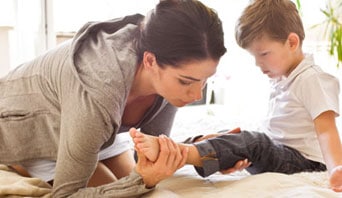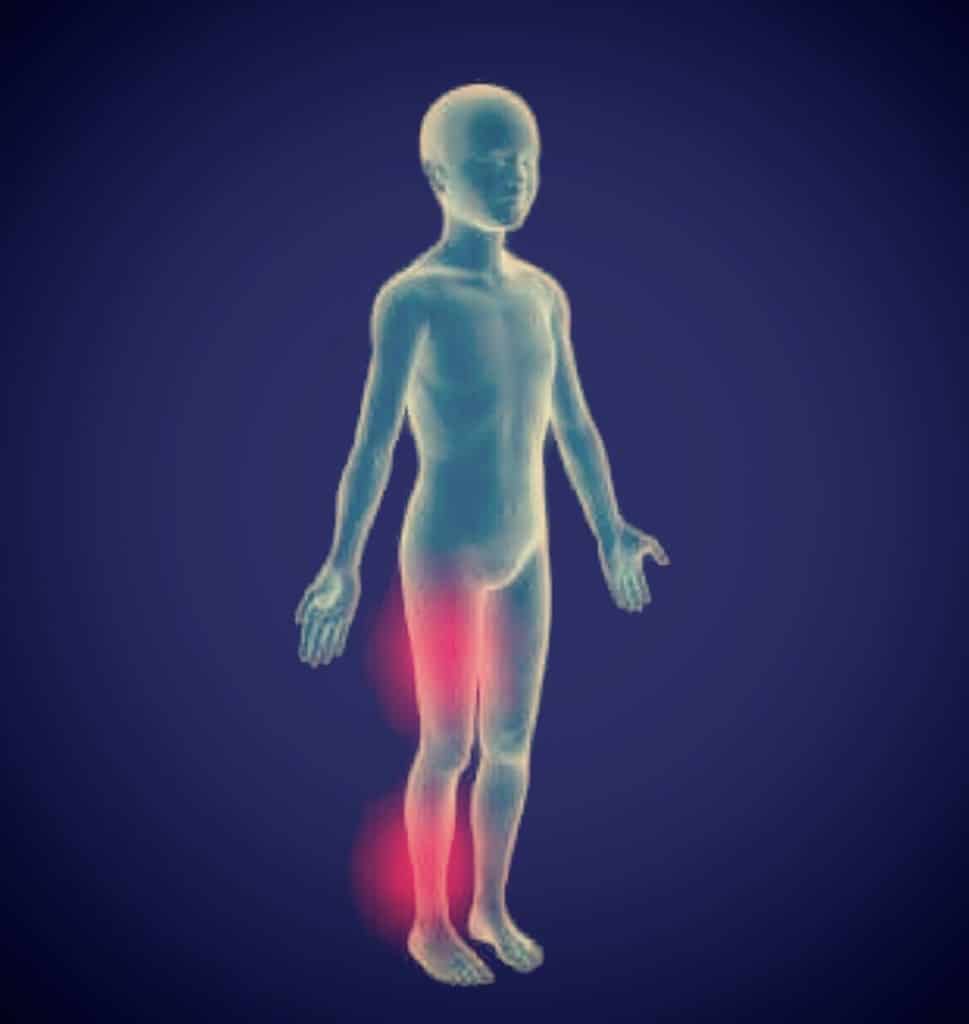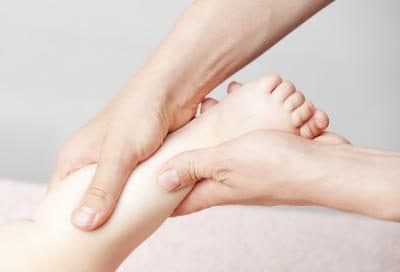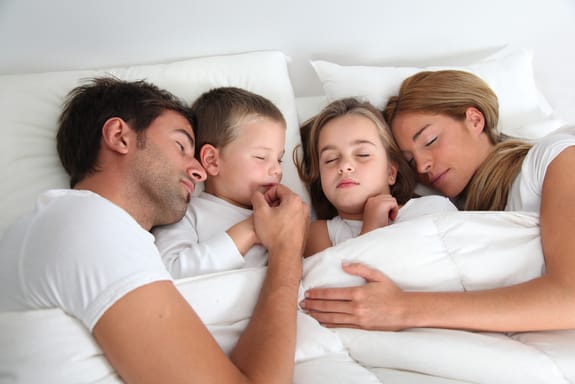My child always wakes up in the middle of the night, crying in pain and clutching his lower legs, complaining that they are sharp and throbbing. Can someone explain to me why?
Growing pains
Growing pains isn’t a disease. Occasional aches and sharp, throbbing pains are very common in children between the ages of 3 and 5 and then again between 8 and 12.
Kids most often feel growing pains in the legs, especially in the front of the thighs, behind the knees, and in the calves. They tend to strike in the late afternoon and evening and during the first hours of sleep at night. The pains are gone by morning.
They can be mild or strong enough to wake your child up. Some kids also have abdominal pain or headaches when they’re having about.
Extremity pain is a common presenting complaint of visits to pediatricians. The most common cause of childhood musculoskeletal pain is termed “growing pains” that exemplifies a type of non-inflammatory pain syndrome. The prevalence of growing pains ranges from 3% to 37% of children.
The Cause
No clear mechanism has yet been identified that explains these pains, but there is an increasing body of evidence indicating that several factors, individually or in combination, might be responsible for this phenomenon. These include mechanical factors, such as joint hypermobility and flat feet, decreased pain thresholds, reduced bone strength, and emotional factors involving the patient’s family and other social stressors.
The term “growing pains” is misleading: Experts don’t know for sure what causes the pain, but it does seem to occur more often after a child has had an especially active day.
Nobody knows why they happen. But one thing is clear: they have nothing to do with growth. The term is used because it is just easier to remember than its medical name, “benign idiopathic nocturnal limb pains of childhood.” Benign meaning it is not harmful, idiopathic means it is from an unknown cause, and nocturnal means it is more active during the night.
Doctors do know that the pains are not linked to dietary deficiency or growth problems. They seem more common in active children, and children with hypermobile joints. And they tend to run in families.
Since bone growth hasn’t been proved to cause pain, “growing” pains might just be aches and discomfort from the jumping, climbing, and running that active kids do during the day. The pains can happen after a child has had a particularly athletic day.
The Symptoms – What your child experience with Growing Pains
- Pain usually occurs in both legs, especially thighs and calves, but may affect one leg at a time and vary which leg or part of the leg is affected.
- Pain occurs almost exclusively in the evenings and night time, often causing awakening during the night.
- Growing pains do not cause limping.
- Pain may occur for months or years, as frequently as almost every night, often with symptom-free intervals of weeks or months.
- Children with growing pains have normal physical exam results.
How to Diagnose
Correct diagnosis of growing pains requires a thorough patient history and physical examination. The diagnosis can be safely established without unnecessary laboratory investigations or imaging. However, identification of one or more clinical cautionary signs, such as unilateral pain, morning stiffness, joint swelling and systemic symptoms (e.g. fever, weight loss and malaise), should trigger an extended evaluation to exclude other more serious conditions that might also present with limb pain. In rare cases, blood tests and X-rays might be done before a doctor diagnoses growing pains.
How to know if it is Growing Pains or Something Else
- Pain is coming from one particular spot. (The doctor may want to do a bone scan to rule out a bone infection or tumor)
- Your child has a fever along with leg pain, and there’s no obvious source for his fever, such as flu symptoms. (A blood test can determine whether there’s an infection)
- He has a lot of pain in one hip, thigh, or knee—or has trouble putting weight on one leg or seems to be limping. (The doctor may order an X-ray to make sure there’s nothing amiss with his bones)
- His pain persists during the day.
- He doesn’t want you to touch or massage the area that hurts. ( It’ll feel good to be massaged if the pain is muscular. If something else is going on, though, it may hurt more if you touch it)
If any of the following symptoms are present, the diagnosis of growing pains is unlikely and you and your doctor should look for other causes.
- Symptoms of general illness, such as fever or weight loss
- Pain specific to a single joint
- Pain worsening with time
- Pain interfering with usual daytime activities
- Limping
- Abnormal joint symptoms – such as restricted motion, redness, swelling, warmth, or tenderness in the related area
One symptom that doctors find most helpful in making a diagnosis of growing pains is how a child responds to touch while in pain. Kids who have pain from a serious medical cause don’t like to be handled because movement can make the pain worse. But those with growing pains respond differently — they feel better when they’re held, massaged, and cuddled.
Clinical Management for Growing Pains
Once the diagnosis has been established, conservative management, using symptomatic pain medications, massage and other supportive measures, should be employed until the syndrome self-resolves with time.
Children get better and episodes can be helped by warm water bottles, rubbing the site of pain, cuddling the child and paracetamol. There is some research showing that stretching muscles helps. But if you have a teenager with leg pain, then it isn’t growing pains, and if it persists it needs investigating.
The treatment for growing pains depends on how much pain your child has. The following things may ease discomfort and help your child feel better: Massaging the legs, stretching the leg muscles (This may be difficult for younger kids), placing a warm cloth or heating pad on the sore leg (Be careful not to burn the skin and do not use during sleep).
If the pain does not get better, ask your health care provider if it’s OK to give your child an over-the-counter pain medicine, such acetaminophen or ibuprofen. Ask about the appropriate dose for your child. Never give aspirin to a child. Aspirin use in children has been linked to a life-threatening disease called Reye’s syndrome.
How a mother in Dubai got rid of her son’s Growing pains ( A true story)
I am a mother of a 7-year-old Autistic child. When my son was 4 year old and completely non-verbal at that time, he would often wake up screaming and crying in the middle of the night; we often had to guess where the origin of the pain was because he had no speech.
Many times we thought it was just his stomach and proceed to massage his tummy or give him something to relieve his gas, until one day our son actually began pointing to his leg. To our utmost horror we realized that our son was having Growing pains and not stomach pains as we had thought earlier.
So the next time he would have another episode of pain we tried different conservative methods like placing a heating pad on his leg, stretching it, often applying Fastum gel to ease his pain and many times giving him a pain relieving medication. We would often cuddle him and massage his legs, yet all these methods provided little or no relief. Often the pain would last for about 30 minutes to an hour. Many times, he would just cry himself to sleep with the excruciating pain.
As a parent, I often wondered if there was any way we could just help our son be free from this devastating ordeal almost ever other night.
One day a friend introduced us to NAET, our son was around 5 years at that time. We were a bit skeptical in the beginning, but decided to try it anyways hoping it would help our son. We began the NAET treatments, after the first 10 treatments we realized he had no more “waking pains” in the middle of the night and had also started to sleep well through the night. To add to it all, he has started talking and broken those years of silence to tell me “No more pain mommy”.
Thank you NAET and goodbye to those many years of silent suffering.
WE can help
Undiagnosed allergies can cause a variety of health and behavioral disorders in children. Through the innovative process of our techniques, health and behavioral disorders in children can be treated in a natural, painless, and non-invasive way.
Rarely is someone allergic to just one substance. It is usually a number of allergens that have caused your immune system to become weakened to the point that you have symptoms. A child could be allergic to many foods, chemicals, and environmental agents.
We use a blend of testing, treatment procedures, and energy balancing from acupuncture/acupressure, allopathy, chiropractic, nutritional, and kinesiological disciplines of medicine. One allergen is treated at a time. By removing the blockages from the energy pathways, We allow the brain and body to regain balance and normal function.
Connect with us through our Facebook page at www.facebook.com/NAETDubai or visit: www.naetdubai.com. You will find a wealth of information here along with an opportunity to speak confidentially through WhatsApp 056-639 0197 or Phone Call 04-420 1633.
You may also email us at admin@naetdubai.com









22 Responses
You’re welcome Candice.
Thanks Manuel! We appreciate it.
Hi, I log on to your blog on a regular basis. Your writing style is awesome, keep up the
good work!
Thank you so much for your comment.Please dont Forget to subscribe to our blogs for any further details please contact us.
Thank you for your comment.Please dont forget to subscribe to our blog and for any further details you can contact us.
Thank you for for your comment please feel free to contact us for any further details.
Thank you so much for your comment. Please don’t forget to subscribe to our blogs. Feel free to contact us if you need any further information.
Very good forum posts. Cheers.
Helpful data. Regards.
Thanks. Excellent stuff.
You explained it fantastically!
Kudos. Lots of knowledge.
With thanks, Fantastic information!
Great postings. With thanks!
Thanks. Awesome information.
You actually reported this effectively.
Seriously quite a lot of great information.
Everything is very open with a precise clarification of the
issues. It was definitely informative. Your site
is very helpful. Thanks for sharing!
Awesome facts. Appreciate it.
Thanks. Plenty of knowledge
Regards. Ample material.